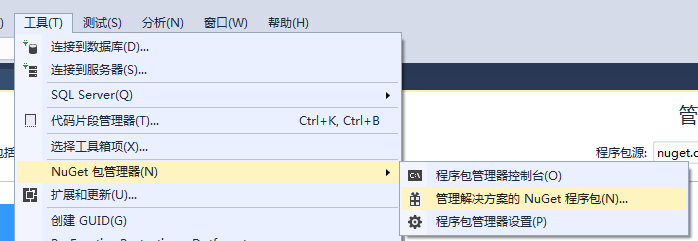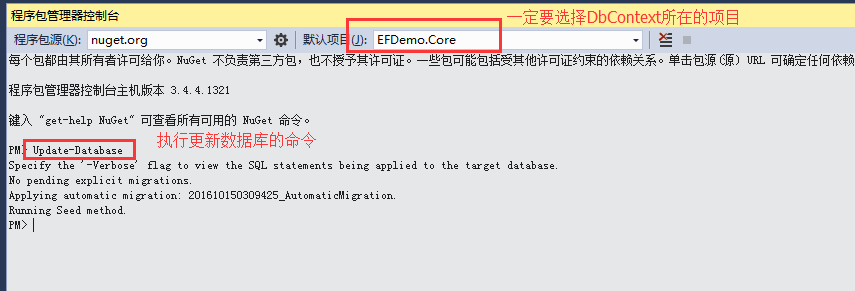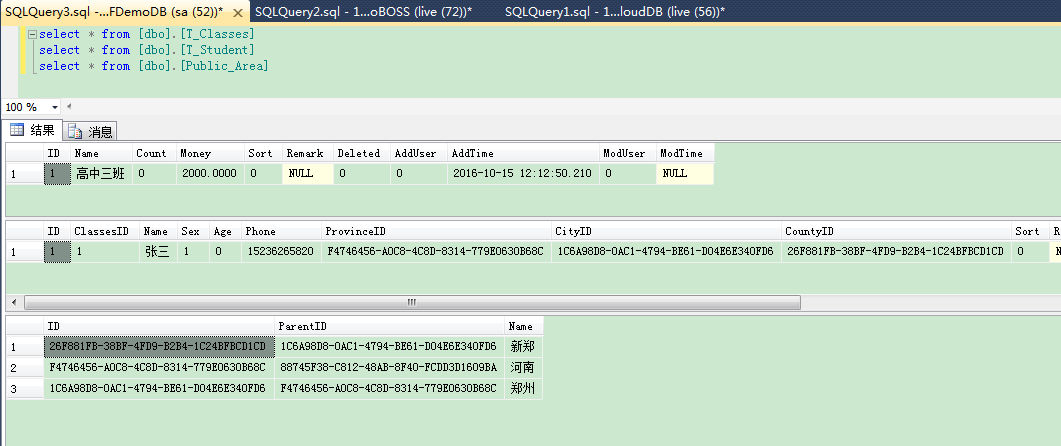EF使用CodeFirst方式生成数据库&技巧经验
前言
EF已经发布很久了,也有越来越多的人在使用EF。如果你已经能够非常熟练的使用EF的功能,那么就不需要看了。本文意在将自己使用EF的方式记录下来备忘,也是为了给刚刚入门的同学一些指导。看完此文,你应该就学会以CodeFirst的方式操作数据库了。
本文主要内容
- CodeFirst生成数据库的流程
- 初始化配置
- 数据库实体构造技巧
- 主外键设置
- decimal精度修改
项目框架搭建
本文所使用的开发工具是vs2015(EF6.1.3)
第一步:新建一个空白项目

第二步:引用EntityFramework


DbContext的初始化配置
DbContext作为操作数据库的网关,十分重要。我们需要对它进行一些类的初始化操作,例如:解决团队开发中,多人迁移数据库造成的修改覆盖问题。
代码如下:
using System; using System.Collections.Generic; using System.Data.Entity; using System.Linq; using System.Text; using System.Threading.Tasks; using System.Data.Entity.ModelConfiguration.Conventions; namespace EFDemo.Core.EF { /// <summary> /// EF访问数据库的接口 /// </summary> public class MyDbContext : System.Data.Entity.DbContext { public MyDbContext() : base("EFDemo") { //解决团队开发中,多人迁移数据库造成的修改覆盖问题。 Database.SetInitializer<MyDbContext>(null); //base.Configuration.AutoDetectChangesEnabled = false; ////关闭EF6.x 默认自动生成null判断语句 //base.Configuration.UseDatabaseNullSemantics = true; } public MyDbContext(System.Data.Common.DbConnection oConnection) : base(oConnection, true) { this.Configuration.LazyLoadingEnabled = true; } protected override void OnModelCreating(DbModelBuilder modelBuilder) { //表名不用复数形式 modelBuilder.Conventions.Remove<PluralizingTableNameConvention>(); //移除一对多的级联删除约定,想要级联删除可以在 EntityTypeConfiguration<TEntity>的实现类中进行控制 modelBuilder.Conventions.Remove<OneToManyCascadeDeleteConvention>(); //多对多启用级联删除约定,不想级联删除可以在删除前判断关联的数据进行拦截 modelBuilder.Conventions.Remove<ManyToManyCascadeDeleteConvention>(); base.OnModelCreating(modelBuilder); } //将实体对象写在这里,就可以生成对应的数据。 如下: //public DbSet<Demo> Demo { get; set; } } }
项目位置:

Migrations下Configuration类的初始化配置
Configuration类的初始化配置十分重要,我们需要通过配置解决一系列迁移问题。例如:允许自动迁移,自动迁移默认情况下不扔掉列在我们的数据库中的表。如果我们不希望这样的行为,我们可以告诉迁移明确允许数据丢失的配置类的AutomaticMigrationDataLossAllowed属性设置为true。
代码如下:
namespace EFDemo.Core.Migrations { using System; using System.Data.Entity; using System.Data.Entity.Migrations; using System.Linq; internal sealed class Configuration : DbMigrationsConfiguration<EFDemo.Core.EF.MyDbContext> { public Configuration() { //允许自动迁移 //不然会报错Unable to update database to match the current model because there are pending changes and automatic migration is disabled. Either write the pending model changes to a code-based migration or enable automatic migration. Set DbMigrationsConfiguration.AutomaticMigrationsEnabled to true to enable automatic migration.You can use the Add-Migration command to write the pending model changes to a code-based migration. //允许自动迁移 AutomaticMigrationsEnabled = true; //自动迁移默认情况下不扔掉列在我们的数据库中的表。如果我们不希望这样的行为,我们可以告诉迁移明确允许数据丢失的配置类的AutomaticMigrationDataLossAllowed属性设置为true。 AutomaticMigrationDataLossAllowed = true; } protected override void Seed(EF.MyDbContext context) { // This method will be called after migrating to the latest version. // You can use the DbSet<T>.AddOrUpdate() helper extension method // to avoid creating duplicate seed data. E.g. // // context.People.AddOrUpdate( // p => p.FullName, // new Person { FullName = "Andrew Peters" }, // new Person { FullName = "Brice Lambson" }, // new Person { FullName = "Rowan Miller" } // ); // } } }
项目位置:

数据库对应实体对象的定义
CodeFirst模式需要我们先定义实体,然后通过实体生成数据。
通常我们设计数据库表时,每个表都有(ID,是否删除,备注,添加人,添加时间,修改人,修改时间)等字段。我们可以用基类处理
基类实体:

using System; using System.Collections.Generic; using System.ComponentModel; using System.ComponentModel.DataAnnotations; using System.ComponentModel.DataAnnotations.Schema; using System.Linq; using System.Text; using System.Threading.Tasks; namespace EFDemo.Core.Entity { public class BaseEntity { } [Serializable] public class BaseEntity<TKey> : BaseEntity { public BaseEntity() { this.AddTime = DateTime.Now; } [Key] [Display(Name = "编号")] public TKey ID { get; set; } [Display(Name = "排序")] [Required(ErrorMessage = "{0}是必填项"), Range(0, int.MaxValue, ErrorMessage = "{0}的范围是{1}到{2}")] [DefaultValue(0)] public int Sort { get; set; } [Display(Name = "备注")] [MaxLength(256, ErrorMessage = "{0}最大长度{1}")] public string Remark { get; set; } [Display(Name = "是否删除")] [Required] public bool Deleted { get; set; } public int AddUser { get; set; } [Display(Name = "添加时间")] [DisplayFormat(ApplyFormatInEditMode = true, ConvertEmptyStringToNull = true, DataFormatString = "{0:yyyy-MM-dd HH mm}", HtmlEncode = false, NullDisplayText = "数据无效")] public DateTime AddTime { get; set; } public int ModUser { get; set; } [DisplayFormat(ApplyFormatInEditMode = true, ConvertEmptyStringToNull = true, DataFormatString = "{0:yyyy-MM-dd HH mm}", HtmlEncode = false, NullDisplayText = "数据无效")] public DateTime? ModTime { get; set; } } }
省市区表:

using System; using System.Collections.Generic; using System.ComponentModel.DataAnnotations; using System.ComponentModel.DataAnnotations.Schema; using System.Linq; using System.Text; using System.Threading.Tasks; namespace EFDemo.Core.Entity { /// <summary> /// 省市区 /// </summary> public class Public_Area { [Key] public Guid ID { get; set; } [Display(Name = "父亲ID")] public Guid ParentID { get; set; } [Display(Name = "名称")] [MaxLength(32, ErrorMessage = "{0}最大长度{1}")] public String Name { get; set; } } }
班级表:

using System; using System.Collections.Generic; using System.ComponentModel.DataAnnotations; using System.ComponentModel.DataAnnotations.Schema; using System.Linq; using System.Text; using System.Threading.Tasks; namespace EFDemo.Core.Entity { /// <summary> /// 班级 /// </summary> public class T_Classes : BaseEntity<int> { public T_Classes() { this.T_Student = new List<Entity.T_Student>(); } [InverseProperty("T_Classes")] public virtual List<T_Student> T_Student { get; set; } [Display(Name = "班级名称")] [Required(ErrorMessage = "{0}是必填项")] [MaxLength(8, ErrorMessage = "{0}最大长度{1}")] public string Name { get; set; } [Display(Name = "人数")] public int Count { get; set; } [Display(Name = "班级经费")] public decimal Money { get; set; } } }
学生表:

using System; using System.Collections.Generic; using System.ComponentModel.DataAnnotations; using System.ComponentModel.DataAnnotations.Schema; using System.Linq; using System.Text; using System.Threading.Tasks; namespace EFDemo.Core.Entity { /// <summary> /// 学生 /// </summary> public class T_Student : BaseEntity<int> { /// <summary> /// 外键 /// </summary> [ForeignKey("ClassesID")] public virtual T_Classes T_Classes { get; set; } [Display(Name = "班级ID")] public int ClassesID { get; set; } [Display(Name = "姓名")] [Required(ErrorMessage = "{0}是必填项")] [MaxLength(8, ErrorMessage = "{0}最大长度{1}")] public string Name { get; set; } [Display(Name = "性别")] public bool Sex { get; set; } [Display(Name = "年龄")] public int Age { get; set; } [Display(Name = "电话")] [Required(ErrorMessage = "{0}是必填项")] [RegularExpression(@"^(13[0-9]|15[0-9]|18[0-9])\d{8}$", ErrorMessage = "不是手机号格式")] [MaxLength(11, ErrorMessage = "{0}最大长度{1}")] public string Phone { get; set; } /// <summary> /// 省市县外键 /// </summary> [ForeignKey("ProvinceID")] public virtual Public_Area Public_Area_Province { get; set; } [Display(Name = "省ID")] public Guid ProvinceID { get; set; } [ForeignKey("CityID")] public virtual Public_Area Public_Area_City { get; set; } [Display(Name = "市ID")] public Guid CityID { get; set; } [ForeignKey("CountyID")] public virtual Public_Area Public_Area_County { get; set; } [Display(Name = "县ID")] public Guid CountyID { get; set; } } }
班级表和学生表是一对多的关系,省市区表和学生表是一对多的关系,同时学生表中有多个省市区表的外键。
项目位置:

使用命令生成数据库
第一步:将实体对象加入到DbContext中,
如下:
//将实体对象写在这里,就可以生成对应的数据。 如下: //public DbSet<Demo> Demo { get; set; } public DbSet<Public_Area> Public_Area { get; set; } public DbSet<T_Classes> T_Classes { get; set; } public DbSet<T_Student> T_Student { get; set; }
第二步:在EFDemo.Core项目下的App.config文件夹中添加生成数据库的配置项

配置文件代码如下:
name="EFDemo"中的EFDemo要和DbContex中的一致。
<?xml version="1.0" encoding="utf-8"?> <configuration> <configSections> <!-- For more information on Entity Framework configuration, visit http://go.microsoft.com/fwlink/?LinkID=237468 --> <section name="entityFramework" type="System.Data.Entity.Internal.ConfigFile.EntityFrameworkSection, EntityFramework, Version=6.0.0.0, Culture=neutral, PublicKeyToken=b77a5c561934e089" requirePermission="false" /> </configSections> <connectionStrings> <!--生成数据库的连接字符串--> <add name="EFDemo" connectionString="Data Source=.;Initial Catalog=EFDemoDB;User ID=sa;Password=123456;MultipleActiveResultSets=True;Application Name=EntityFramework" providerName="System.Data.SqlClient" /> </connectionStrings> <entityFramework> <defaultConnectionFactory type="System.Data.Entity.Infrastructure.LocalDbConnectionFactory, EntityFramework"> <parameters> <parameter value="mssqllocaldb" /> </parameters> </defaultConnectionFactory> <providers> <provider invariantName="System.Data.SqlClient" type="System.Data.Entity.SqlServer.SqlProviderServices, EntityFramework.SqlServer" /> </providers> </entityFramework> </configuration>
第三步:执行更新命令
启动项目一定要选择EFDemo.Core

生成数据库如下:


主外键关系设置
班级和学生一对多关系的设置:

一个表中的多个外键是另一个表中的主键的情况:学生表和省市县表

生成的数据库如下:

需要注意的是:这种情况,在Public_Area表中不能反向设置 public virtual List<T_Student> T_Student ,不然会报错。
decimal怎么保存四位小数
decimal默认保留两位小数,我们需要通过如下设置让其保留四位小数。
在DbContext中配置班级表中的Money字段让其保留四位小数:

执行Update-Database命令:
结果如下:

使用EF操作数据库数据
第一步:
让EFDemo.Web应用EFDemo.Core程序集。
第二步:
配置EFDemo.Web中的webconfig中的数据库连接字符串:
<connectionStrings> <!--操作数据库的连接字符串--> <add name="EFDemo" connectionString="Data Source=.;Initial Catalog=EFDemoDB;User ID=sa;Password=123456;MultipleActiveResultSets=True;Application Name=EntityFramework" providerName="System.Data.SqlClient" /> </connectionStrings>
第三步:
使用EF向数据库添加数据
public ActionResult Index() { using (var db = new Core.EF.MyDbContext()) { Public_Area area1 = new Public_Area() { ID = Guid.NewGuid(), Name = "河南", ParentID = Guid.NewGuid() }; db.Public_Area.Add(area1); Public_Area area2 = new Public_Area() { ID = Guid.NewGuid(), Name = "郑州", ParentID = area1.ID }; db.Public_Area.Add(area2); Public_Area area3 = new Public_Area() { ID = Guid.NewGuid(), Name = "新郑", ParentID = area2.ID }; db.Public_Area.Add(area3); //添加测试数据 T_Classes classes = new T_Classes() { Name = "高中三班", Money = 2000 }; db.T_Classes.Add(classes); T_Student student = new T_Student() { ClassesID = classes.ID, Name = "张三", Phone = "15236265820", Sex = true, ProvinceID = area1.ID, CityID = area2.ID, CountyID = area3.ID, }; db.T_Student.Add(student); db.SaveChanges(); } return View(); }
第四步:
查看数据库数据

Demo完整代码下载



 浙公网安备 33010602011771号
浙公网安备 33010602011771号